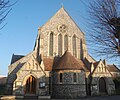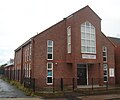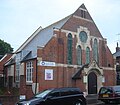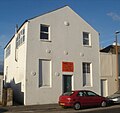| Name |
Image |
Location |
Denomination/
Affiliation |
Grade |
Notes |
Refs |
St Mary's Church
(More images) |
 |
Broadwater
50.8278°N 0.3733°W / 50.8278; -0.3733 (St Mary's Church, Broadwater) |
Anglican |
I |
Broadwater's parish church has Saxon origins, but the present structure is late Norman. Nairn and Pevsner noted that the cruciform building, of flint with stone dressings, has impressive arches. The chancel was extensively remodelled in the 19th century. |
[33][42]
[43][44]
[45][46] |
St Mary's Church
(More images) |
 |
Goring-by-Sea
50.8130°N 0.4246°W / 50.8130; -0.4246 (St Mary's Church, Goring-by-Sea) |
Anglican |
II* |
Decimus Burton rebuilt this late Norman church in the Gothic style in 1837. Hans Feibusch's mural representing Christ in Majesty, designed in 1954, is above the chancel arch. The exterior is rendered. |
[44][47]
[48][49]
[50] |
St Andrew's Church
(More images) |
 |
West Tarring
50.8247°N 0.3958°W / 50.8247; -0.3958 (St Andrew's Church, West Tarring) |
Anglican |
II* |
West Tarring's partly 13th-century parish church, in the Early English style, has Italian mosaic designs by William Butterfield in 1885, when a major restoration took place. Its longstanding ecclesiastical status as a peculier of Canterbury Cathedral may have influenced its design. |
[14][31]
[51][52]
[53] |
Christ Church
(More images) |
 |
Worthing
50.8132°N 0.3737°W / 50.8132; -0.3737 (Christ Church, Worthing) |
Anglican |
II* |
Worthing's second Anglican church, built in 1840–1843 as a chapel of ease to Broadwater and parished in 1855, was reprieved from closure in 2006. The flint building also uses artificial stone—an early example of this. The chancel was altered in 1894, when a hammerbeam roof—likened to Bryant and May matchsticks by Harry Stuart Goodhart-Rendel—was added. |
[18][30]
[54][55]
[56][57]
[58][59] |
St Symphorian's Church
(More images) |
 |
Durrington
50.8364°N 0.4133°W / 50.8364; -0.4133 (St Symphorian's Church, Durrington) |
Anglican |
II |
The ancient parish church was wrecked during the English Civil War, and remained disused until Lacy W. Ridge built a new structure incorporating its remains. It opened in 1916 and was extended (with a chancel) in 1941. |
[1][60]
[61][62]
[63][64] |
St George's Church
(More images) |
 |
East Worthing
50.8142°N 0.3573°W / 50.8142; -0.3573 (St George's Church, East Worthing) |
Anglican |
II |
George Truefitt's Bargate stone, Decorated Gothic-style church was consecrated in 1868 and extended in 1875 and 1884. The chancel and adjacent aisle have large apses, and there is a bell-tower with a spirelet. The interior was refitted in 1990–91. |
[30][44]
[65][66]
[67][68]
[69] |
St Botolph's Church
(More images) |
 |
Heene
50.8136°N 0.3867°W / 50.8136; -0.3867 (St Botolph's Church, Heene) |
Anglican |
II |
The ancient chapel at Heene was ruined by the 18th century and partly dismantled in 1766. A fragment remains near the present church flint and stone church, built in the Early English style in 1873 by Edmund Scott and enlarged in 1905. |
[13][44]
[66][70]
[71][72]
[73] |
St John the Divine Church
(More images) |
 |
West Worthing
50.8147°N 0.4004°W / 50.8147; -0.4004 (St John the Divine Church, West Worthing) |
Anglican |
II |
In 1937, N.F. Cachemaille-Day built a brick and flint church to replace a mission chapel linked to St Botolph's. This building of 1900 was incorporated into the new structure, which was extended in 1965 when the short, broad tower and spire were added. |
[44][66]
[73][74]
[75] |
St Andrew the Apostle's Church
(More images) |
 |
Worthing
50.8153°N 0.3774°W / 50.8153; -0.3774 (St Andrew the Apostle's Church, Worthing) |
Anglican |
II |
Worthing's first "High Church" Anglican church was so controversial that it stood unused for six years while liturgical differences were thrashed out. Arthur Blomfield's Early English church, eventually consecrated in 1888, uses flint and stonework extensively. |
[30][66]
[76][77]
[78][79]
[80] |
Queen Street Church Centre
(More images) |
 |
Broadwater
50.8240°N 0.3760°W / 50.8240; -0.3760 (Queen Street Church Centre, Broadwater) |
Anglican |
– |
This combined church and community centre was built in 1993–1994 on the site of the former Broadwater Mission Hall, administered from St Mary's Church. The present church is part of St Mary's parish. |
[17][33]
[81] |
| St Stephen's Church |
 |
East Worthing
50.8231°N 0.3604°W / 50.8231; -0.3604 (St Stephen's Church, East Worthing) |
Anglican |
– |
Between 1929 and 1959, this was a mission chapel to St Mary's Church in Broadwater; but it was consecrated in 1959 and became a separate church in its own right. It remains within the parish of St Mary's. |
[1][33]
[81] |
All Saints Church
(More images) |
 |
Findon Valley
50.8504°N 0.3959°W / 50.8504; -0.3959 (All Saints Church, Findon Valley) |
Anglican |
– |
A church hall, erected in 1936, was used for services in this interwar housing estate until Leonard Keir Hett's brick church of 1956 was consecrated on 22 February of that year. The congregation chose the dedication. The church was parished in 1989, and St Peter's Church at High Salvington was added to the parish in 2010. |
[17][82]
[83][47] |
St Laurence's Church
(More images) |
 |
Goring-by-Sea
50.8090°N 0.4074°W / 50.8090; -0.4074 (St Laurence's Church, Goring-by-Sea) |
Anglican |
– |
Part of the parish of Goring-by-Sea, this church was founded in 1936. An attached hall was added in 1962. The interior has a 15th-century altarpiece retrieved from St Mary's Church, Slaugham. |
[44][84] |
St Peter's Church
(More images) |
 |
High Salvington
50.8485°N 0.4081°W / 50.8485; -0.4081 (St Peter's Church, High Salvington) |
Anglican |
– |
The vicar of St Symphorian's Church paid for a tin tabernacle to be erected in High Salvington in 1928. It was part of St Symphorian's parish between 1951 and 2010—since when it has been linked to All Saints Church at Findon Valley—and is Worthing's only iron church. |
[1][60]
[66][83]
[85][86] |
St Richard's Church
(More images) |
 |
Maybridge
50.8210°N 0.4183°W / 50.8210; -0.4183 (St Richard's Church, Maybridge) |
Anglican |
– |
This postwar housing estate north of Goring-by-Sea received a permanent church in 1966, when Romilly Craze's brick building opened. A church hall designed by John Leopold Denman had accommodated services since 1954. A parish was created in 1980. |
[1][66]
[87] |
St Matthew's Church
(More images) |
 |
Worthing
50.8179°N 0.3830°W / 50.8179; -0.3830 (St Matthew's Church, Worthing) |
Anglican |
– |
R.S. Hyde's Early English-style church has an apse and a narrow flèche, and uses locally quarried flint. It was built in 1899 and extended with vestries and aisles in 1911. |
[1][30]
[66][88]
[89] |
Broadwater Baptist Church
(More images) |
 |
Broadwater
50.8270°N 0.3648°W / 50.8270; -0.3648 (Broadwater Baptist Church) |
Baptist |
– |
R.W. Brough's 1968 brick structure is the successor to a church hall used since 1937 by Broadwater's Baptist community, which had first met in 1881 in a former stable. Another building, registered as Baptist School Chapel, on a site on nearby Penfold Road was also used between 1904 and 1937. |
[22][25]
[62][90]
[91][92]
[93][94] |
East Worthing Baptist Church
(More images) |
 |
East Worthing
50.8156°N 0.3525°W / 50.8156; -0.3525 (East Worthing Baptist Church) |
Baptist |
– |
In 1933, an Evangelical community founded a church in East Worthing; it was opened by Worthing's mayor the following year. The Baptist Church acquired the building, a brick structure designed by T.R. Hyde, in 1946. As East Worthing Evangelical Free Church it was registered for worship in December 1934; it was re-registered for Baptists in January 1947. |
[22][95]
[96][97]
[98] |
Findon Valley Free Church
(More images) |
 |
Findon Valley
50.8475°N 0.3966°W / 50.8475; -0.3966 (Findon Valley Free Church) |
Baptist |
– |
The present octagonal-shaped building was designed by R.W. Brough in 1958 and registered in October of that year, but this church has its origins in a church founded by Worthing Baptist Church in Findon in 1906, before the Findon Valley estate existed. It moved to a wooden building there in 1939. |
[82][47]
[99][100]
[101][102]
[103] |
West Worthing Baptist Church
(More images) |
 |
West Tarring
50.8199°N 0.3926°W / 50.8199; -0.3926 (West Worthing Baptist Church) |
Baptist |
– |
The present building is in three linked parts: Resta Moore's original "school chapel" of 1900, which superseded a hall used by the Baptist community since 1890; Norman Myers's 1938 extension; and an adjacent community and social centre completed in 1988. The church was registered in July 1938, replacing the original building. |
[62][95]
[104][105]
[106][107] |
Worthing Baptist Church
(More images) |
 |
Worthing
50.8159°N 0.3752°W / 50.8159; -0.3752 (Worthing Baptist Church) |
Baptist |
– |
Worthing's first permanent Baptist place of worship opened on this site in 1881. Resta Moore built an extension of brick and flint four years later, and two more enlargements followed as the church's popularity grew. Its members helped to establish several Baptist churches within and outside Worthing. The church was registered for the solemnisation of marriages in April 1886. |
[22][25]
[62][108]
[109][110] |
Worthing Tabernacle
(More images) |
 |
Worthing
50.8148°N 0.3712°W / 50.8148; -0.3712 (Worthing Tabernacle) |
Evangelical |
II |
James Lund's pale stone and dark brick building blends the Gothic and Romanesque Revival styles and has a distinctive rose window. It was built in 1908 to accommodate the Evangelical congregation who had previously worshipped at the Montague Street Tabernacle Chapel (built in 1839), and was registered in July of that year. |
[22][44]
[111][108]
[112][113]
[114][115]
[116][117] |
Maybridge Community Church
(More images) |
 |
Maybridge
50.8188°N 0.4186°W / 50.8188; -0.4186 (Maybridge Community Church) |
Evangelical |
– |
Founded in 1954 on the Maybridge housing estate, this Evangelical church is associated with the Worthing Tabernacle. The original structure, part of a former hospital, was rebuilt here; it has since been extended. As Maybridge Evangelical Free Church it was registered for worship in February 1955 and for marriages in February 1969. |
[99][118]
[119] |
West Worthing Evangelical Church
(More images) |
 |
West Worthing
50.8162°N 0.3985°W / 50.8162; -0.3985 (West Worthing Evangelical Church) |
Evangelical |
– |
James Lund, designer of the Worthing Tabernacle, adopted a different design—the Queen Anne style—for this church of 1912, built to serve an Evangelical community who had worshipped at a private house since 1900. |
[22][99]
[115][120] |
| River of Life Church |
 |
Worthing
50.8216°N 0.3735°W / 50.8216; -0.3735 (Broadwater Christian Fellowship) |
Evangelical |
– |
This Art Deco building was used by Christian Scientists between 1939 and 1987; it replaced a 1921 structure on the same site. After that congregation moved to West Worthing, the church was acquired by a congregation planted out of the New Life Church at Durrington. Under the name Oasis Centre, it was registered for worship and for marriages in May 1993, and it has also had the name Broadwater Christian Fellowship. |
[22][115]
[121][122]
[123][124]
[125] |
Clifton Community Church
(More images) |
 |
Worthing
50.8164°N 0.3782°W / 50.8164; -0.3782 (Clifton Community Church, Worthing) |
Evangelical |
– |
This Gothic-style stone and brick church has been used by several religious groups, including Baptists and Brethren, since it opened in 1905, and has undergone many changes of name. Its present status is Evangelical. |
[22][111]
[115][126]
[127][128] [129] |
St Mary of the Angels Church
(More images) |
 |
Worthing
50.8132°N 0.3773°W / 50.8132; -0.3773 (St Mary of the Angels Church, Worthing) |
Roman Catholic |
II |
Henry Clutton's brick and Portland stone French Gothic-style church—Worthing's oldest public place of Roman Catholic worship—was opened in 1864 and completed in 1939 when Frederick Walters added a chancel. |
[23][25]
[66][130]
[131][132]
[133][134]
[135] |
Church of the English Martyrs
(More images) |
 |
Goring-by-Sea
50.8158°N 0.4277°W / 50.8158; -0.4277 (Church of the English Martyrs, Goring-by-Sea) |
Roman Catholic |
– |
The concrete church opened in 1968 to replace Jupp's Barn, the former barn of Jupp's Farm, which dated from 1771: this had been converted into a church in 1934 and registered in 1952. It is now the church hall. In the present "utilitarian concrete" church, parishioner Gary Bevans painted a scale replica of the Sistine Chapel ceiling on the ceiling between 1988 and 1993. |
[25][26]
[27][136]
[137][138] |
St Michael's Church
(More images) |
 |
High Salvington
50.8419°N 0.4049°W / 50.8419; -0.4049 (St Michael's Church, High Salvington) |
Roman Catholic |
– |
This church moved to its present location in 1966 from Durrington, where the parish was formed in 1927 and a chapel was erected in 1938. The modernist design "departs from any conventionality" according to English Heritage. It was registered for worship and for marriages in October 1966. |
[23][25]
[66][139]
[140][141]
[142] |
Offington Park Methodist Church
(More images) |
 |
Broadwater
50.8290°N 0.3808°W / 50.8290; -0.3808 (Offington Park Methodist Church, Broadwater) |
Methodist |
– |
The Wesleyan Methodist community acquired this site in 1928; the first church was opened in 1932 and was registered in October that yar, but it was replaced in 1958 with a new 400-capacity brick structure by architect Graeme Highet. The new building was registered in March 1959. Additions were made in the grounds in the 1970s. |
[22][62]
[143][121]
[144][145]
[146][147] |
Goring Methodist Church
(More images) |
 |
Goring-by-Sea
50.8135°N 0.4301°W / 50.8135; -0.4301 (Goring Methodist Church, Goring-by-Sea) |
Methodist |
– |
Methodist worship in Goring-by-Sea started in a local hall in 1945, and a permanent church was built six years later by John Leopold Denman. The long, low brick building has a small bronze spire. It was registered for worship in March 1951 and for marriages in April 1952. |
[99][136]
[148]
[149]
[150] |
Goring United Reformed Church
(More images) |
 |
Goring-by-Sea
50.8162°N 0.4102°W / 50.8162; -0.4102 (Goring-by-Sea United Reformed Church) |
United Reformed Church |
– |
World War II delayed the construction of this church for 11 years until 1949; a school was used for worship instead. The building, which was registered in April 1949, became the church hall in 1961 when a new church, in brick and concrete and with exterior walls forming a series of V-shapes, opened. |
[19][148]
[136][151]
[152] |
Emmanuel United Reformed Church
(More images) |
 |
Heene
50.8122°N 0.3860°W / 50.8122; -0.3860 (Emmanuel United Reformed Church, Heene) |
United Reformed Church |
– |
Founded in 1926 as St Columba's Presbyterian Church, the original church (registered in 1932) became the church hall in 1937 when it was replaced by an Art Deco structure with a tower and variegated brickwork to the design of Frederic Lawrence. St Columba's and Shelley Road United Reformed Churches united in 2005 when the building in Shelley Road was closed. |
[18][22]
[62][89]
[153][154]
[155][156] |
Worthing Christadelphian Church
(More images) |
 |
Worthing
50.8167°N 0.3783°W / 50.8167; -0.3783 (Worthing Christadelphian Church) |
Christadelphians |
– |
This community worships in a church used between 1961 and 1969 by Theosophists, who had a presence in Worthing from 1924. The structure was altered in 1989. It was registered for marriages by Christadelphians in September 1971. |
[22][111]
[157][158]
[159][160] |
St Demiana and Pope Kyrillos VI Coptic Orthodox Church
(More images) |
 |
Worthing
50.8118°N 0.3664°W / 50.8118; -0.3664 (Cornerstone Methodist Church, Worthing) |
Coptic Orthodox |
– |
Architect John Wills was commissioned to build a replacement for the Bedford Row Methodist Chapel; his Early English style building, in rag-stone and featuring a corner tower, was completed in 1899 and opened in 1900. The church was reprieved from closure in 2003, at which time it was called Steyne Gardens Methodist Church, but it was announced in July 2015 that it would close at the end of August that year (by which time it had been renamed Cornerstone Methodist Church). It was bought by the Coptic Orthodox Church in Britain and Ireland in 2017 and opened the following year. |
[19][22]
[115][133]
[161][162]
[163][164] |
Christian Brethren Hall
(More images) |
 |
West Worthing
50.8178°N 0.3951°W / 50.8178; -0.3951 (Christian Brethren Hall, West Worthing) |
Exclusive Brethren |
– |
This small hall, built and registered in 1934 but given its present appearance by a 1950s remodelling, is the only extant Brethren place of worship in Worthing; three others are no longer used. It is part of the Exclusive Brethren movement which separated from what is now the Plymouth Brethren Christian Church in 1970. |
[22][95]
[165] |
Kingdom Hall
(More images) |
 |
West Worthing
50.8175°N 0.3953°W / 50.8175; -0.3953 (Kingdom Hall, West Worthing) |
Jehovah's Witnesses |
– |
This opened in 2015 on the site of the former Second Church of Christ, Scientist in Grand Avenue near West Worthing railway station. The purpose-built Kingdom Hall replaced a converted house on nearby South Street which had been the fifth Jehovah's Witnesses place of worship in Worthing since the denomination was established locally in 1922. The new building was registered for marriages in July 2015. |
[22][122]
[166] |
| Church of Jesus Christ of Latter-day Saints, Worthing Chapel |
 |
Goring-by-Sea
50.8182°N 0.4330°W / 50.8182; -0.4330 (Church of Jesus Christ of Latter-day Saints, Goring-by-Sea) |
Latter-day Saint |
– |
The congregation, whose first meetings were held in 1964, numbered more than 300 by the 1980s, so a permanent church was built. The brick building opened in 1984 and was registered for worship and for marriages in August of that year. |
[122][167]
[168] |
| Elim Church Worthing |
 |
Worthing
50.8208°N 0.3725°W / 50.8208; -0.3725 (Elim Church Worthing) |
Pentecostal |
– |
Since the Elim Tabernacle in Grosvenor Road closed in 1982, the Pentecostal community has used several venues, including this converted house on Broadwater Road. |
[22][122]
[169] |
Friends Meeting House
(More images) |
 |
West Worthing
50.8144°N 0.3962°W / 50.8144; -0.3962 (Friends Meeting House, West Worthing) |
Quaker |
– |
Quakers first met in Worthing in the 1920s and were peripatetic until 1945, when a private house was registered. In 1958 they opened their own meeting house behind Mill Road, bought the previous year for £7,000, and registered it in January 1958. The building was originally a garage and boathouse. The premises have been shared with Spiritualists, Unitarians and others at various times. |
[22][122]
[111][170]
[171][172] |
Salvation Army Citadel
(More images) |
 |
Worthing
50.8104°N 0.3766°W / 50.8104; -0.3766 (Salvation Army Citadel, Worthing) |
Salvation Army |
– |
The Army has a controversial history in Worthing: their arrival in 1883 caused riots, led by a mob called the Skeleton Army. Peaceful relations had been established by the time a permanent citadel replaced temporary barracks accommodation in 1912. The building was registered in 1919. |
[22][115]
[108][173]
[174][175]
[176] |
Worthing Spiritualist Church
(More images) |
 |
Worthing
50.8128°N 0.3738°W / 50.8128; -0.3738 (Worthing Spiritualist Church) |
Spiritualist |
– |
This Art Nouveau-influenced building, designed by a local architect, was opened for worship by Sir Arthur Conan Doyle in 1926, although it was built earlier. Its original name, under which it was registered in April 1926, was Spiritualist Mission Church. |
[22][111]
[115][177]
[178] |
Masjid Assalam
(More images) |
 |
Worthing
50.8193°N 0.3700°W / 50.8193; -0.3700 (Masjid Assalam Mosque, Worthing) |
Sunni Islam |
– |
Worthing's mosque doubles as a cultural and social centre for the local Muslim population. An early-morning arson attack in 2005 caused substantial damage, but the building has been repaired. The mosque, which was registered in March 1995, had more than 1,000 worshippers in 2003. |
[179][180]
[181][182] |
|


 Media related to Religious buildings in Worthing at Wikimedia Commons
Media related to Religious buildings in Worthing at Wikimedia Commons































































